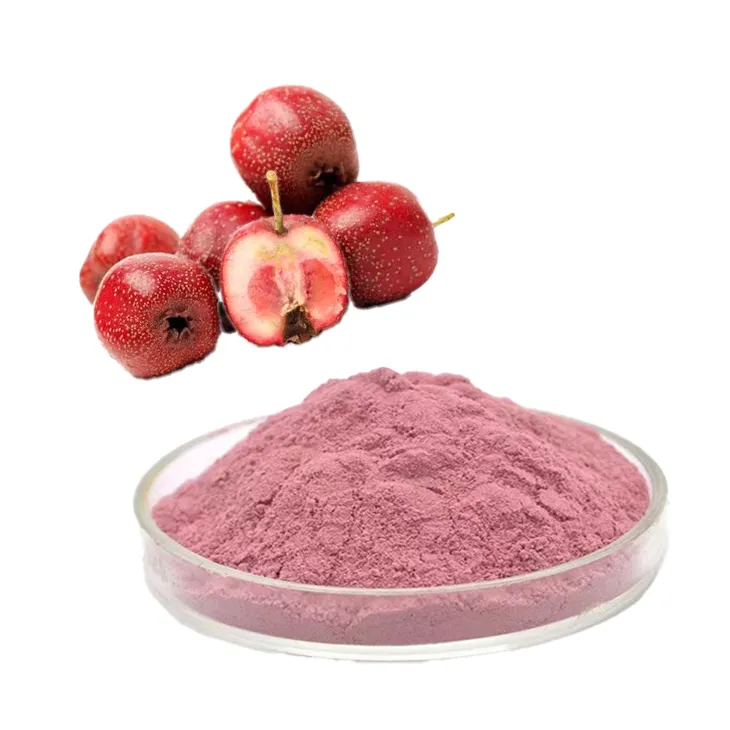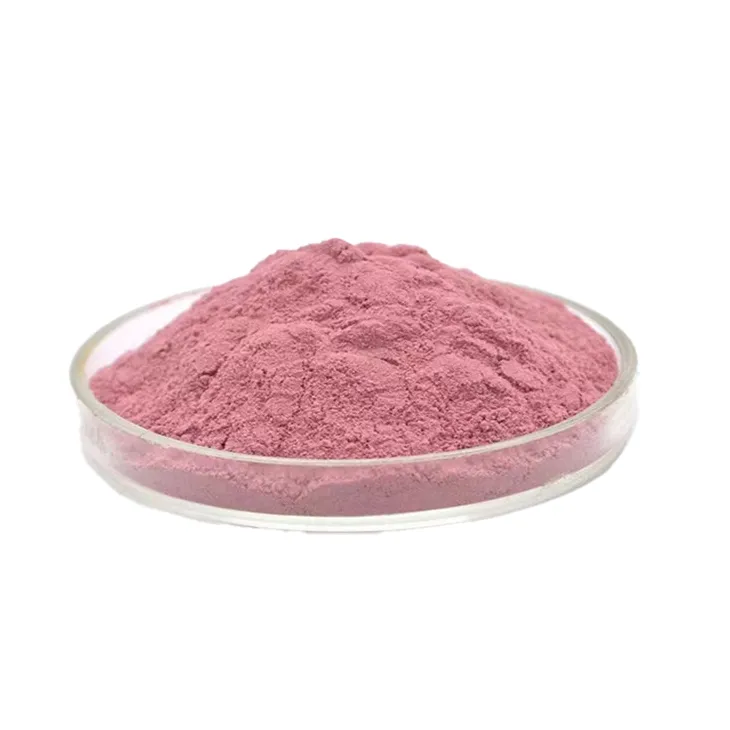- 0086-571-85302990
- sales@greenskybio.com
Hawthorn powder: China vs. the United States.
2024-11-28

1. Botanical Sources
1.1 In China
In China, the main botanical source for Hawthorn powder is Crataegus pinnatifida. This species is widely distributed across China. It is a deciduous shrub or small tree that thrives in various environments, especially in mountainous areas. The fruits of Crataegus pinnatifida are rich in nutrients and have been used in traditional Chinese medicine for centuries.
1.2 In the United States
In the United States, several species of hawthorn are used for making Hawthorn powder, with Crataegus laevigata and Crataegus oxyacantha being among the most common. These species are native to North America and are also found in different habitats, including forests and open fields. The fruits of these American hawthorn species also possess certain nutritional and medicinal properties.
2. Manufacturing Techniques
2.1 In China
- Harvesting: In China, hawthorn fruits are usually harvested when they are fully ripe. This is typically in the late autumn. Workers carefully pick the fruits to avoid damage. - Cleaning: After harvesting, the fruits are thoroughly washed to remove dirt, debris, and any pesticides or other contaminants. - Drying: The cleaned fruits are then dried. This can be done through natural sun - drying or using drying machines. Sun - drying is a traditional method, which may take a longer time but can preserve the natural flavor better. Machine - drying is more efficient and can control the drying conditions precisely. - Grinding: Once dried, the hawthorn fruits are ground into a fine powder. Modern grinding machines are often used to ensure a uniform particle size.
2.2 In the United States
- Harvesting: Similar to China, in the United States, hawthorn fruits are harvested at the appropriate time when they reach maturity. However, the harvesting process may vary depending on the scale of production, with some large - scale farms using mechanical harvesters. - Sorting and Cleaning: After harvesting, the fruits are sorted to remove unripe or damaged ones and then thoroughly cleaned. - Processing: Some American manufacturers may use different processing methods. For example, they may first extract certain active ingredients from the hawthorn fruits before drying and grinding them into powder. This extraction process may involve the use of solvents or other techniques to isolate specific compounds. - Packaging: In the United States, great attention is paid to packaging to ensure the quality and freshness of the Hawthorn powder. Packaging materials are often selected to protect the powder from moisture, light, and air.
3. Nutritional Values
3.1 In China
Chinese hawthorn powder is rich in various nutrients. It contains a significant amount of vitamins, such as vitamin C, which is important for immune function and skin health. It also has minerals like potassium, which is beneficial for heart health and maintaining proper fluid balance in the body. Additionally, Chinese hawthorn powder contains flavonoids. These flavonoids have antioxidant properties, which can help protect the body against oxidative stress and reduce the risk of chronic diseases.
3.2 In the United States
American - sourced hawthorn powder also offers valuable nutritional components. It contains similar vitamins and minerals as the Chinese variety. For example, it is a good source of vitamin E, which is an antioxidant that helps protect cells from damage. The flavonoids in American hawthorn powder also play a role in promoting cardiovascular health. They can help relax blood vessels, improving blood flow and reducing blood pressure.
4. Regulatory Policies
4.1 In China
- Food Safety Standards: In China, hawthorn powder is subject to strict food safety regulations. The production process must comply with national food safety standards, which cover aspects such as hygiene, quality control, and labeling requirements. - Traditional Chinese Medicine Regulations: Since hawthorn has a long history of use in traditional Chinese medicine, if hawthorn powder is marketed as a traditional Chinese medicine product, it also needs to meet the relevant regulations of traditional Chinese medicine. This includes requirements for raw material quality, processing methods, and efficacy verification.
4.2 In the United States
- Food and Drug Administration (FDA) Regulations: In the United States, the FDA regulates hawthorn powder as a dietary supplement. Manufacturers are required to ensure the safety of their products. They must also provide accurate labeling, including information about ingredients, dosage, and potential side effects. - Good Manufacturing Practice (GMP) Requirements: Hawthorn powder manufacturers in the United States are expected to follow GMP requirements. This ensures that the products are produced in a clean, controlled, and consistent manner.
5. Similarities
- Nutritional Composition: Both Chinese and American hawthorn powders share some common nutritional components, such as vitamins, minerals, and flavonoids. These components contribute to their potential health - promoting effects. - Growing Importance: In both countries, hawthorn powder is becoming increasingly popular due to its potential health benefits. It is being recognized as a natural and healthy product. - Quality Control Awareness: There is an increasing awareness of quality control in both China and the United States. Manufacturers in both countries are taking steps to ensure the safety and quality of their hawthorn powder products.
6. Differences
- Botanical Varieties: As mentioned earlier, the main botanical sources in China and the United States are different species of hawthorn, which may lead to some differences in nutritional content and medicinal properties. - Manufacturing Emphasis: Chinese manufacturing may place more emphasis on traditional drying and grinding methods to preserve the natural properties of hawthorn, while American manufacturing may focus more on extraction techniques to isolate specific active ingredients. - Regulatory Frameworks: The regulatory frameworks in the two countries are different. China has a more comprehensive regulatory system for hawthorn powder, especially when it is related to traditional Chinese medicine, while the United States regulates it mainly as a dietary supplement.
FAQ:
Question 1: What are the main botanical sources of hawthorn powder in China and the United States?
In China, the main botanical source for hawthorn powder is Crataegus pinnatifida. In the United States, it is often sourced from various native hawthorn species such as Crataegus laevigata. However, different regions within each country may also use other closely related hawthorn species depending on availability and traditional usage.
Question 2: How do the manufacturing techniques of hawthorn powder differ between China and the United States?
In China, traditional manufacturing techniques may involve drying the hawthorn fruits thoroughly first, and then grinding them into powder. Modern processes may also include steps like sterilization and quality control to meet food safety standards. In the United States, the manufacturing may focus more on industrial - scale production with advanced machinery for drying, grinding, and packaging. There may also be a greater emphasis on standardizing the particle size and consistency of the powder compared to some traditional Chinese methods.
Question 3: What are the main nutritional values of hawthorn powder in both countries?
Both in China and the United States, hawthorn powder is known to be rich in vitamins such as vitamin C. It also contains flavonoids which have antioxidant properties. Additionally, it may have some dietary fiber. However, the exact nutritional composition can vary depending on factors like the variety of hawthorn used and the manufacturing process. For example, some Chinese hawthorn powders may retain more of certain traditional nutrients due to less processing - intensive methods in some cases.
Question 4: Are there differences in the regulatory policies regarding hawthorn powder in China and the United States?
Yes, there are differences. In China, hawthorn powder is regulated as a food product. There are strict regulations regarding its production, quality control, and labeling. In the United States, the Food and Drug Administration (FDA) regulates hawthorn products. It must meet certain safety and quality standards for sale in the market. However, the specific requirements and the scope of regulation may vary in terms of aspects like allowed additives, and the claims that can be made on the product labels.
Question 5: Can hawthorn powder from China be sold in the United States and vice versa?
It is possible, but it must meet the regulatory requirements of the destination country. If Chinese hawthorn powder wants to be sold in the United States, it needs to comply with FDA regulations regarding food safety, labeling, and any import restrictions. Similarly, for US - made hawthorn powder to be sold in China, it must adhere to Chinese food regulations which may include specific quality and labeling requirements.
Related literature
- Hawthorn: Botany, Chemistry, and Pharmacology"
- "Regulatory Frameworks for Herbal Products in China and the United States"
- "Nutritional Composition of Hawthorn and its Derivatives"
- ▶ Hesperidin
- ▶ Citrus Bioflavonoids
- ▶ Plant Extract
- ▶ lycopene
- ▶ Diosmin
- ▶ Grape seed extract
- ▶ Sea buckthorn Juice Powder
- ▶ Fruit Juice Powder
- ▶ Hops Extract
- ▶ Artichoke Extract
- ▶ Mushroom extract
- ▶ Astaxanthin
- ▶ Green Tea Extract
- ▶ Curcumin
- ▶ Horse Chestnut Extract
- ▶ Other Product
- ▶ Boswellia Serrata Extract
- ▶ Resveratrol
- ▶ Marigold Extract
- ▶ Grape Leaf Extract
- ▶ New Product
- ▶ Aminolevulinic acid
- ▶ Cranberry Extract
- ▶ Red Yeast Rice
- ▶ Red Wine Extract
-
American Ginseng Root Extract
2024-11-28
-
Troxerutin
2024-11-28
-
Artichoke Extract
2024-11-28
-
Epimedium extract powder
2024-11-28
-
Beetroot Powder
2024-11-28
-
Eyebright Extract
2024-11-28
-
Genistein
2024-11-28
-
Oyster Mushroom Extract Powder
2024-11-28
-
Agaricus Blazei Extract
2024-11-28
-
Longan Extract
2024-11-28





















